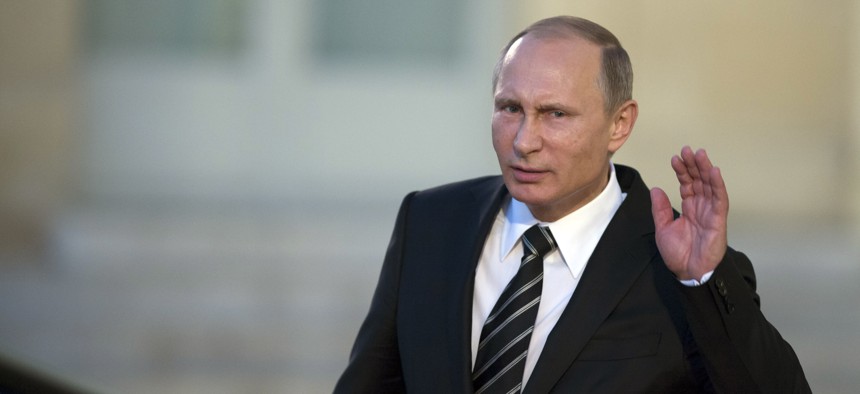
Russian President Vladimir Putin holds his hand on his ear while listening to a newsman’s question as he leaves the Elysee Palace in Paris, France. Friday, Oct. 2 , 2015. AP Photo/Alexander Zemlianichenko
Why Containment Won’t Work Against Putin's Russia
The Kremlin has essentially weaponized globalization.
The signs of the times are everywhere. Estonia is erecting a 2.5-meter-high metal mesh fence reinforced with barbed wire along much of its border with Russia—and backing it up with high-tech drones, sensors, radars, and cameras. Neighboring Latvia has announced plans to build fences along its eastern frontier. Poland plans to build new state-of-the art watchtowers on its border with Russia’s Kaliningrad exclave.
And, of course, Ukraine has floated plans to build a wall along its Russian frontier. A new era of containment, it appears, has begun. Russia’s neighbors, wary of polite little green men appearing to stir up new non-declared hybrid wars, are building walls and becoming vigilant.
And some leading Western commentators are calling for a revival of the spirit of George Kennan’s Long Telegram and Mr. X article, which comprised the philosophical basis for the Western policy of containing an expansionist Soviet Union. Writing in Foreign Affairs in November 2014, Rutgers University-Newark professor Alexander Motyl called on the West to “develop a serious, steady, long-term policy response to Russian expansionism. And that, of course, means containment.”
Likewise, James Goldgeier, dean of the School of International Service at American University, wrote in Slate that “a revived strategy of containment is necessary to counter Russian aggression.” Soviet-era defector Aleksandr Goldfarb made a similar argument in a recent blog post.
So, to paraphrase Kennan, can a newly aggressive Moscow “be contained by the adroit and vigilant application of counterforce at a series of constantly shifting geographical and political points, corresponding to the shifts and maneuvers” of Russian policy?
NATO’s moves at last year’s summit in Wales—setting up military facilities in the Baltic states, Poland, and Romania, rotating troops through countries on the alliance’s eastern flank, and establishing a new rapid-response force that could assist endangered members within two days—certainly seem like steps in that direction. In a speech this week, U.S. Defense Secretary Ash Carter said Washington “will take all necessary steps to deter Russia’s malign and destabilizing influence, coercion, and aggression."
But 1947 this isn’t. And any serious attempt to contain Vladimir Putin’s Russia—which unlike the Soviet Union is deeply integrated into the global economy—will bear scant resemblance to its Cold War antecedent. This is because unlike the Cold War, when the world was divided into two hermetically sealed systems, today’s conflict between Moscow and the West comes at a time when Russia is very much embedded in the West and has proven adept at exploiting its transparency for nontransparent ends.
And unlike the Soviet Union, today’s Russia isn’t an ideological power seeking global hegemony through military expansion. It is essentially a crime syndicate masquerading as a state. Putin and the made men who make up his inner circle deploy corruption as a tool of statecraft in order to perpetuate their rule, expand their reach, and enrich themselves.
In a 2012 report for Chatham House, James Greene noted how Putin used “the corrupt transnational schemes that flowed seamlessly from Russia into the rest of the former Soviet space—and oozed beyond it” to extend his “shadow influence beyond Russia’s borders and develop a natural, ‘captured’ constituency.”
Toward this end, Moscow has used everything from shady energy deals, to webs of shell companies, to hot money in the City of London, to the financing of extremist political parties in Europe. Its success in doing so raises the economic cost of conflict, reduces resolve to resist Moscow, and gives Russia a ready-made lobby in Western capitals. The Kremlin has effectively weaponized globalization.
Rather than an Iron Curtain with armies facing off across the Fulda Gap, the main fault line of the current conflict is between a Western zone of transparency and a Moscow-dominated sphere of corruption. Any containment policy, therefore, needs first and foremost to limit Russia’s sphere of corruption and extend the Western zone of transparency.
“The front lines of containment are the non-Russian states in the potential path of Russian expansion. Seen in this light, a divided Ukraine occupies the same role in today’s containment strategy as a divided Germany did in yesterday’s,” Motyl wrote in Foreign Affairs. “Ukraine should therefore be the recipient of similar financial, political, and military assistance.”
Georgia and Moldova, likewise, fall into this category. But any true containment of today’s Russia must go beyond this. It also needs to include a rollback of Russia’s ability to exploit and abuse the dynamism and transparency of Western economies.
Part of this is in place with sanctions that deny Russia access to credit from Western banks. Part of it would require shedding light on the web of shadowy shell companies and structures Russia has established in Europe to launder money and stealthily buy influence, as well as bringing more transparency to things like London’s property market.
It would also involve, as Motyl notes, “constraining Russia’s ability to use energy as a weapon.” This reducing Europe’s dependency on Russian natural gas, and strict enforcement of EU antitrust legislation vis-a-vis Gazprom.
And a key weapon in reserve, of course, includes banning Russia from the SWIFT network, which manages secure financial transactions worldwide. The thing about a crime syndicate is that it needs a legitimate economy to feed off of. And denying Putin & Co. this would go a long way toward containing them.
NEXT STORY: The Boko Haram War Machine Is Far from Defeated




